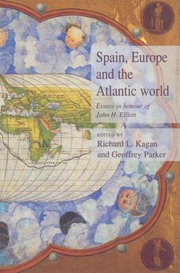Book contents
- Frontmatter
- Contents
- Notes on contributors
- Acknowledgements
- List of abbreviations
- Sir John Elliott: an appreciation
- Introduction
- PART I Power and propaganda: the world of the court
- PART II The pattern of society: community and identity in Habsburg Spain
- PART III Spain and its empire
- 10 David or Goliath? Philip II and his world in the 1580s
- 11 Olivares, the Cardinal-Infante and Spain's strategy in the Low Countries (1635–1643): the road to Rocroi
- 12 Conquest after the conquest: the rise of Spanish domination in America
- 13 Heeding Heraclides: empire and its discontents, 1619–1812
- 14 Why were Spain's special overseas laws never enacted?
- Index
11 - Olivares, the Cardinal-Infante and Spain's strategy in the Low Countries (1635–1643): the road to Rocroi
Published online by Cambridge University Press: 04 August 2010
- Frontmatter
- Contents
- Notes on contributors
- Acknowledgements
- List of abbreviations
- Sir John Elliott: an appreciation
- Introduction
- PART I Power and propaganda: the world of the court
- PART II The pattern of society: community and identity in Habsburg Spain
- PART III Spain and its empire
- 10 David or Goliath? Philip II and his world in the 1580s
- 11 Olivares, the Cardinal-Infante and Spain's strategy in the Low Countries (1635–1643): the road to Rocroi
- 12 Conquest after the conquest: the rise of Spanish domination in America
- 13 Heeding Heraclides: empire and its discontents, 1619–1812
- 14 Why were Spain's special overseas laws never enacted?
- Index
Summary
In terms of territory and dependencies, the Spanish monarchy in early modern times was essentially a Mediterranean and trans-Atlantic empire. It extended across the southern flank of Europe and included an immense portion of the New World. Yet, paradoxically, during most of the age of Spanish greatness, the principal strategic pivot and main military base of the monarchy was located far from both the main territorial blocs of which the empire was composed – in northern Europe. In the opening decades of Spain's ascendancy down to the 1530s, its principal armies operated in Italy or the Iberian peninsula itself. But from the 1540s onwards, for well over a century, the Spanish crown chose to concentrate its military might, resources and expenditure, and thus its capacity to influence international affairs, in the Low Countries. This remarkable enduring strategic posture ceased only with the peace of the Pyrenees (1659) when Spain definitively lost its place at the head of the European powers, to France, and turned its efforts to attempting to recover Portugal.
There were several reasons for this, at first sight, rather illogical choice of main strategic base but the most compelling, during much of this long period, was the need to combat French power and influence, France being Spain's chief rival for hegemony in Europe.
- Type
- Chapter
- Information
- Spain, Europe and the AtlanticEssays in Honour of John H. Elliott, pp. 267 - 295Publisher: Cambridge University PressPrint publication year: 1995
- 1
- Cited by



